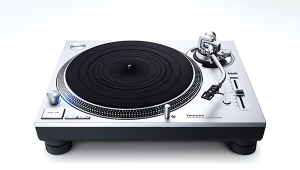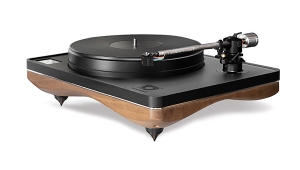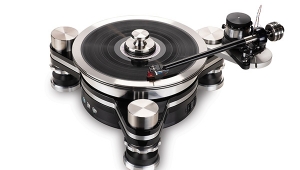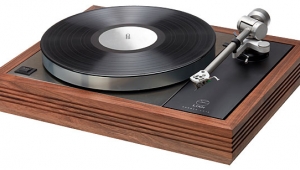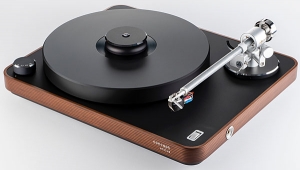| Columns Retired Columns & Blogs |
Versa Dynamics 2.0 LP player Page 2
The arm parts are machined from steel and aluminum, and, except for the carriage rod and the knurled end "handle," are black-anodyzed. Every physical parameter is adjustable by means of Allen wrenches (supplied, footnote 1), setup is quite simple, and the adjustments don't interact. You can even change VTA while the unit is playing a disc, though tangency readjustment is then required.
Footnote 1: These are the nicest Allen wrenches I've ever seen; they're shaped like a T, with the top (handle) bar heavily covered with some tough, bright red plastic material which makes the wrench a snap to handle. They are made (appropriately) by the Allen Corp.—J. Gordon Holt
There is no arm as such; rather, there is a short arm carriage consisting of two pieces: a removable magnesium "headshell," which accommodates the cartridge, and the main air-bearing assembly. The interface between these is two precision-machined, lapped surfaces, and the pieces are held together by a single stout bolt. Assembled, the two sections behave as one, providing a rigid path from the cartridge to the body of the arm. (Even with the pump on, there is no perceptible play whatsoever between the carriage and the arm rod. How this is achieved I do not know, but I'll take my word for it.)
The back of the arm is fitted with an adjustable (or removable) eddy-current "brake" which can be used to provide additional damping of the cartridge's LF resonance (footnote 2). Whether or not this damping is needed will depend on how much internal damping there is in the cartridge you use, and I found it was not needed with my preferred Ortofon MC-2000. The description of the system's performance, below, refers to the arm's use without the added damping.
The control module is a smallish metal box with three bat-handle toggle switches at one end. The module installs near the turntable, and allows one to control from the listening area both the 'table itself and (through the controller wire) the remotely located pump. When the 'table is turned completely off, a 24V AC supply in the pump module is applied continuously to the controller cable. When the main power-up switch on the controller is turned on, the 24V control circuit energizes a relay in the pump module, which turns on the pump motor.
The second switch on the controller has three positions. In the Down position, the disc vacuum is shut off and the platter motor is off; Mid position turns on the disc vacuum but leaves the platter motor off. In the Up position, everything turns on. This switch is cycled with the play of each disc. Finally, the third switch is to select the 33 or 45rpm platter speeds. Neither of these has a vernier adjustment, although both were precisely on speed, according to a strobe check.
The pump unit contains a single motor coupled through a common shaft to both the vacuum and pressure pumps (for the platter spindle/cartridge carrier and for the disc hold-down, respectively), and these must be connected to the controller via two thin plastic hoses and a light wire controller cable. Fifty feet of each is supplied, which would seem to offer a wide choice of pump locations. But there may be less choice than there seems, as the pump unit is quite noisy.
The pump is available in a stripped-down (naked) version or, for $600 extra, with an optional noise-reduction enclosure. Our system came with the enclosure already installed, but even so, I measured 77dB of noise at 1 foot from the pump intake. The majority of the noise is at 20 and 40Hz, so it will radiate in all directions from the source, dissipating exponentially with distance through the air. My listening area, and the adjacent areas, are at ground level and have concrete floors, and with the pump in the adjoining room and about 40' from where I sit, I could hear the 40Hz noise component with the intervening door open, but could still hear it, albeit barely, when the door was closed and I held my breath. And that was with everything on a very inert concrete floor. There is no question that the pump would have been much more audible on a typical wooden floor.
Since compression tends to condense moisture out of the air, the pump is equipped with a condensing coil and a drain reservoir, which latter gathers and holds any condensate until the system is completely shut down. At this time, a drain valve (held shut by a solenoid while the pump is running) opens and the remaining compressed air expels the water. This happens automatically every time the system is powered down. If the system is operated for several hours straight, the platter On switch won't start the platter, and the LED next to the switch will start blinking. This means you must shut the system off (for about 30 seconds) to purge the water reservoir.
Note that this is a time function, and not the result of a Reservoir Full sensor. Under extremely high humidity conditions, beads of moisture may be observed on the carriage rod, indicating that a purge is in order even though the system has not signalled the need for it. Water in the system will not harm anything, but it will impair the arm's operation and so should be eliminated if it occurs. The instructions for doing this are clear and detailed. In fact, the entire 20-page instruction manual for this system is exemplary in its clarity, literacy, and freedom from typos.
Footnote 1: These are the nicest Allen wrenches I've ever seen; they're shaped like a T, with the top (handle) bar heavily covered with some tough, bright red plastic material which makes the wrench a snap to handle. They are made (appropriately) by the Allen Corp.—J. Gordon Holt
Footnote 2: An eddy current is a circulating electric current (like the mini whirlpools produced by turbulence in the flow of water) which is induced in a sheet of any electrically conductive material by a magnetic field moving relative to the plane of the material. The magnetic field emanating from the eddy current has opposite magnetic polarity to the external magnetic field, so that interaction tends to oppose any change in their relative position (Lenz's Law: the induced field opposes the field that induced it). That is, the external field is moved in the plane of the sheet of material; it will tend to drag the sheet along with it.
The phenomenon can be used for mechanical braking, as when an unchanging magnetic field is passed through the surface of a rotating metal disc or, in the case of the Versa Dynamics arm, when an unchanging but moving magnetic field is passed through a fixed metal strip. Conversely, an alternating magnetic field can be made to rotate a pivoted metal disc as in the familiar household power meter.—J. Gordon Holt
- Log in or register to post comments
